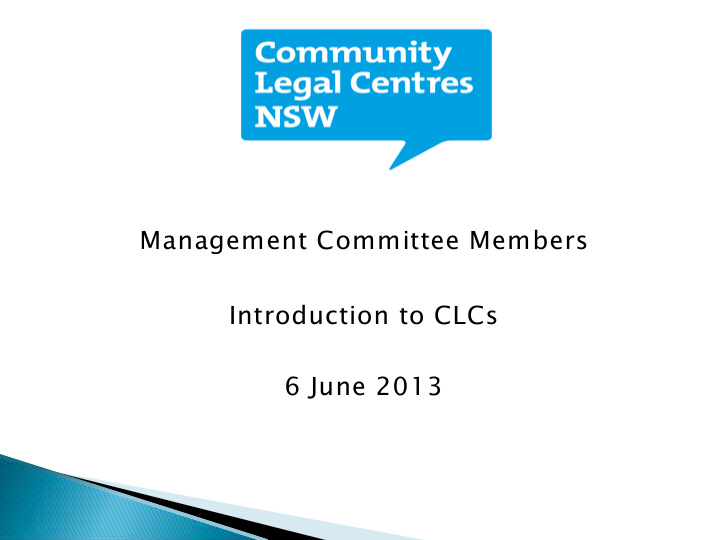



Management Committee Members Introduction to CLCs 6 June 2013
} A “snapshot” of the Community Legal Sector } CLCNSW } Justice Sector Agencies } Current issues } A brief overview of the role of the management committee } Questions
Let’s go back to the beginning…
Where and when was the first community legal centre in Australia established?
Fitzroy Legal Centre in Melbourne, Victoria 18 December 1972
Name one reason why CLCs came into existence.
Primarily because of a concern that many people in the community were unable to access legal assistance because of costs or other barriers. CLCs developed with a philosophy of holistic and accessible service provision.
What is a CLC? } A non profit organisation independent from government, commercial and professional bodies } Community-based organisation whose goals and priorities are established in response to the geographic community and/or community of interest it serves.
What is a CLC? Aims to: } ◦ carry on a legal practice ◦ develop effective ways of informing the community of its legal rights and responsibilities ◦ provide disadvantaged sections of the community with access to legal and related information and/or services ◦ advocate for the development of laws, administrative practices and a legal justice system which are fair, just and equitable ◦ develop and maintain close links with the community it serves to ensure that areas of unmet need are detected and appropriate services developed
A brief history of CLCs ◦ Social justice movement in early 1970s ◦ Volunteer-run free legal information and advice ◦ 1977: first CLC in Redfern
Funding of CLCs ◦ Commonwealth ◦ State ◦ Public Purpose Fund ◦ Other sources (Fair Trading) ◦ Managed by Legal Aid NSW
Areas of work/staffing in CLCs ◦ Civil ◦ Family ◦ Criminal ◦ Principal Solicitor / Coordinator ◦ Solicitors / Community workers
Membership ◦ 37 full members (CLCs) ◦ 3 associate members
Board and Committees ◦ Board ◦ Subcommittees: Finance Staffing Aboriginal Legal Access Program Sector Development Membership compliance
State Office ◦ Director ◦ ALAP Community Development Worker ◦ Regional Accreditation Coordinator ◦ Advocacy & Human Rights Officer ◦ Sector Development Coordinator ◦ Administrator ◦ Finance Officer ◦ Volunteers (interns, including PLT students)
} Aboriginal Legal Access Program } Accreditation } Advocacy and Human Rights } Sector Development
} Held February, May, August, November } 2 day meetings } Network meetings and professional development sessions } Includes General Meetings at end of second day } Legal Training Day and Leadership Day
} Practice Insurance Committee (PII) } Coordinators/Directors/Sector Development } Law Reform & Policy (which has a number of working groups) } RRR (Rural, Regional, Remote) } Aboriginal Advisory Group } Community Legal Education workers (CLEW) } Administrators and Finance } Domestic Violence and Victims Compensation committee .
} There are two meetings at each quarterlies for which the CLCNSW Rules requires each member CLC to send a representative. } PII and General Meetings.
NACLC: National Association of Community Legal Centres Peak body for all CLCs in Australia. CLCNSW is NSW member.
NLAF NSW Legal Assistance Forum } An interagency forum that brings together key legal service providers across government, non government and private sectors. } NLAF aims to facilitate access to justice for socially and economically disadvantaged people by: ◦ improving the way services and programs are designed and delivered ◦ promoting cooperative arrangements and collaboration between organisations within the community and justice sectors ◦ promoting the development of innovative ways of servicing marginalised groups in the community, based on relevant research and identified gaps in existing legal services.
} Legal Aid NSW } Law & Justice Foundation } Law Society } Department of Attorney General and Justice } Bar Association } Pro bono partners
} Rollover of funding agreements } Funding principles
} Governance versus Management } Governance is the work of the Board, day to day management is the work of Coordinator / Principal Solicitor / staff
} Constitution - mission, purpose & objects } Do you have a copy / know what’s in the constitution? } Mission – what / how / why and “core value” } Does the mission statement truly reflect the Centre’s work? } Review regularly (annually?)
} Legal and ethical responsibilities } Ensure adhere to Federal / State law } Effective HR, WH&S policies } Conflict of interest policy – Board, management, staff, volunteers } Understand Coordinator’s responsibility to hire / fire staff
} Strategic planning } Ensure effective planning } Regular review of programs and services } SWOT } Translate mission into realistic & effective goals } Reporting processes against plan
} Accreditation } Understand and support the NACLC accreditation scheme
} Resources – financial and people } Oversee adequacy / funding / new opportunities } Annual budget process – discuss / understand / oversight } Financial reporting procedures } Support Coordinator / Principal Solicitor
} Public relations, promotion and committee/board membership } Ambassador for Centre
} Governance training } CLCNSW is able to provide this to all CLC MCs in NSW } Contact State Office for more information.
?????????
Recommend
More recommend